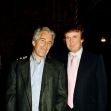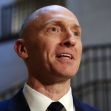Perhaps inspired by the old proverb that advises, “If you throw enough mud at a wall, some of it will stick,” Donald Trump has sued Hillary Clinton and scores of others for “orchestrating an unthinkable plot” that “shocks the conscience and is an affront to the nation’s democracy.” All these nefarious acts, he claims, occurred during his successful 2016 campaign for the presidency and continue today.
In a 108-page complaint that asks for $24 million in damages and a trial by a Florida jury, the ex-President claims that Clinton and her co-defendants collaborated to “weave a narrative” about his collaboration with Russia. In their quest to win the election, he claims, they committed “crimes that make Watergate pale in comparison.” These include “falsifying evidence, deceiving law enforcement, and exploiting access to highly-sensitive data.” He says their efforts were aimed at “destroying his life, his political career and rigging the 2016 Presidential Election in favor of Hillary Clinton.”
Trump filed his tirade-filled complaint in the Southern District of Florida by lawyers from Deerfield Beach, Florida, and Bedminster, New Jersey. In it, he details his version of how “Clinton and her cohorts tried to “vilify him through a scheme that was designed to “cripple his bid for the presidency” by “fabricating a scandal.”
It contains 16 counts. Count 1 alleges a Racketeer Influenced and Corrupt Organizations (RICO) conspiracy by Clinton and her co-defendants that consisted of a “wide-ranging and fraudulent scheme to concoct a false narrative that the Plaintiff and his campaign were colluding with Russia to undermine the 2016 Presidential Election.” Their acts, he says, amounted to an illegal obstruction of justice and also violated the Trade Secrets Act when they illegally stole Trump’s secret business papers.
Count Two continues his RICO claims giving additional details about how defendants “conspired and acted in concert for the express purpose of injuring the Plaintiff’s political career and/or impeding his ability to effectively govern through a pattern of racketeering activity.” Count Three is for “injurious falsehood,” due to defendants’ dissemination of false and damaging statements. Count Four alleges a “conspiracy to commit injurious falsehood. Count Five is for malicious prosecution” when defendants misled FBI and DOJ officials about him. Count Six charges Clinton and her co-defendants with “conspiracy to commit malicious prosecution” by committing acts that led to federal investigations about Trump.
Count Seven is for violation of the Computer Fraud and Abuse Act, stemming from the alleged computer hacks committed by defendants. Count Eight claims “theft of trade secrets” during those hacks. Count Nine is for violation of the Stored Communications Act, due to “unauthorized access” to Trump’s computers at home and while he was serving in the White House. Count Ten is entitled “Agency” and alleges that Clinton facilitated a “scheme to hire dishonest operatives to put together a collection of lies and innuendo about the plaintiff and shop it to the FBI.”
Counts 11-16 allege Repsondeat Superior/Vicarious Liability by which the law firm Perkins Coie, the Democratic National Committee (DNC), the Clinton campaign and defendants Orbis, Fusion and Neustar are all responsible for the ’tortious conduct” of their employees. Orbis is an “intelligence firm,” Fusion is a research firm, and Neustar is an information technology company.
Trump then provided his version of how Clinton was never actually connected to these illegal activities due to a “wall of third parties” constructed by attorney-client privilege that hid what Perkins Coie, “a law firm with deep Democratic ties,” was doing. The firm, he states, was “tasked with spearheading the scheme” of proving “a sinister link” between Trump and Russia.
He charged that one law partner, Marc Elias, produced “opposition research” while another, Michael Sussman, created “misleading evidence of a bogus back-channel connection between e-mail servers at Trump Tower and a Russian-owned bank.” The result of Elias’ efforts, Trump said, culminated in what is now known as the Steele Dossier, a controversial report by Christopher Steele, a former intelligence officer for British intelligence (MI6). The accuracy of the Dossier, which was leaked and published by BuzzFeed News without Steele’s permission, has been a subject of much debate. In addition, Trump alleged that another law partner, Michael Sussman, hacked servers in Trump Tower and the White House.
Throughout these activities, Clinton’s people, he alleges, spread lies about him through social media, public appearances and press releases. These prompted an investigation by the FBI, which he charged was spending taxpayer dollars to “advance the baseless probe,” that ultimately exonerated him. He also states that the Department of Justice continues to investigate him in a Clinton-headed “effort to ensure he will never be elected again.”
Several times, Trump described the involvement of FBI Director James Comey, who he says “was aligned with the Clinton campaign.” Comey, it should be noted, sent a letter to Congress on October 28, just days before the election that disclosed how Clinton’s aide Huma Abedin, regularly forwarded emails containing classified information to her husband, the “disgraced former Congressman” Anthony Weiner. Several commentators believe the Comey letter was responsible for Clinton’s loss.
Trump’s complaint lists and describes 21 additional defendants in addition to Clinton, the DNC, Perkins Coie and its lawyers. He also names Does 1-10 who are “currently unknown” but likely to include “journalists, publishers, editors, Investigators, state or federal officials, co-conspirators, officers, employees, agents, managers, owners, principals and/or other duly authorized individuals.” Finally, he adds ten “presently unidentifiable” defendants who are somehow affiliated with the ABC Corporation and other media that allegedly collaborated with the Clinton campaign.
He next details the DNC-led misdeeds that undermined both Trump and Bernie Sanders, her leading opponent. This was followed by 16 pages that describe “tortious and criminal acts” by the Clinton campaign, the DNC, and Perkins Coie, which, he added, does not give Hilary Clinton attorney-client privilege because their communications were “non-legal” and made “in furtherance of criminal and fraudulent wrongdoing.”
The complaint next provides details about the creation and distribution of the Steele Dossier and how it came about. In great detail he describes the alleged activities of private investigators, a private intelligence firm that employed a Russian analyst with “intimate ties to the Clinton campaign,” employees at the Department of Justice, a public relations firm, and Steele.” All of these, he alleges, were funded by Clinton’s campaign and served to “cast malicious dispersions” on Trump.
He next turned to Clinton’s alleged cyberattacks against the campaign conducted by the Neustar technology company under the direction of Sussman and Perkins Coie and again, funded by the Clinton campaign.
In detail after detail, including dates, interactions with people tied to either political party or the media, Trump lays out his case. Halfway through his complaint, he describes how “A String of Federal Investigations Clear Donald J. Trump and Uncover Defendant’s Illicit Conspiracy.” He describes how Comey “took retaliatory action” against Trump for firing him. These actions purportedly led to the appointment of Robert Mueller as Special Counsel to investigate Trump’s ties to Russia, which ultimately, he said, “found no evidence of collusion” after a 22-month investigation.
Finally, Trump claims that continuing false attacks by Clinton and her co-defendants are causing Trump “significant injuries and damages,” and that their “overall fraudulent scheme to discredit and delegitimize him…amounts to no less than …$24 million in damages including “the loss of existing and future business opportunities that continue to accrue.”
Observers can’t help but wonder at the timing of this lawsuit, which echoes others offenses that many call The Trump Playbook. Whether the lawsuit is linked to the backlash from what he called the “genius” of Putin’s war on Ukraine, his ever-mounting legal troubles, or his decline in the polls, is yet to be discovered. But he clearly believes that an additional $24 million will help soothe his wounds and pay for more mud.






